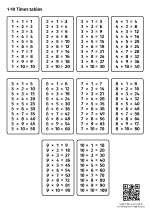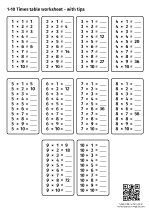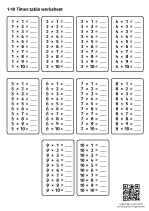Welcome to Multiplication Chart Tables, the ultimate online resource for learning and practicing multiplication facts. Whether you are a student, a teacher, or a parent, you will find everything you need to master the times tables in a fun and easy way.
Multiplication Chart Tables offers you:
- Free printable multiplication charts (times tables) in PDF format. You can choose from different colors, sizes, and formats, and print them for your personal or classroom use. You can also download blank charts and fill them in yourself. ¹
- Tips and tricks to help you memorize and recall the multiplication facts. You can learn about patterns, strategies, and shortcuts that make multiplication easier and faster. You can also find out how to apply multiplication to real-world problems.
- Upcoming! Interactive multiplication games and quizzes that test your knowledge and speed. You can play online or download them to your device. You can also customize the difficulty level, the number range, and the time limit. ²
- Upcoming! AI-powered multiplication tutor that adapts to your learning style and pace. You can learn new multiplication facts, review old ones, and get instant feedback and support. You can also track your progress and achievements. ³
Multiplication Chart Tables is designed to make math learning accessible, engaging, and rewarding for everyone. Whether you want to improve your grades, prepare for exams, or just have fun with math, Multiplication Chart Tables is the perfect platform for you.
Start your multiplication journey today by exploring our website and discovering all the features and benefits we offer. You can also follow us on [social media] to get the latest updates, news, and offers.
Multiplication Chart Tables: The best way to learn and practice multiplication facts!
Strategies for multiplication table of 1
Multiplying any number by 1 gives the same number. For example, 1×5=5, 1×9=9, etc. This is also called the identity property of multiplication.
Strategies for multiplication table of 2
Adding the number to itself is the same as multiplying it by 2. For example, 2×5=5+5=10, 2×9=9+9=18, etc. This is also called the doubling strategy.
Strategies for multiplication table of 3
Adding the number to itself twice is the same as multiplying it by 3. For example, 3×5=5+5+5=15, 3×9=9+9+9=27, etc. This is also called the tripling strategy.
Strategies for multiplication table of 4
Doubling the number and then doubling it again is the same as multiplying it by 4. For example, 4×5=5+5=10, 10+10=20, 4×9=9+9=18, 18+18=36, etc. This is also called the double-double strategy.
Strategies for multiplication table of 5
Multiplying the number by 10 and then dividing it by 2 is the same as multiplying it by 5. For example, 5×5=5×10=50, 50÷2=25, 5×9=9×10=90, 90÷2=45, etc. This is also called the halving strategy. You can also notice that the last digit of the product alternates between 5 and 0.
Strategies for multiplication table of 6
When you multiply 6 by an even number, the last digit of the product is the same as the last digit of the even number. For example, 6×2=12, 6×4=24, 6×6=36, etc. This is also called the even-ending rule.
Strategies for multiplication table of 7
The 7 times table is likely to take more practice than the others. It's good idea to use inversion, learning other tables first. And using different memorization techniques.
Strategies for multiplication table of 8
Doubling the number three times is the same as multiplying it by 8. For example, 8×5=5+5=10, 10+10=20, 20+20=40, 8×9=9+9=18, 18+18=36, 36+36=72, etc. This is also called the triple-double strategy.
Strategies for multiplication table of 9
Multiplying the number by 10 and then subtracting the number from the result is the same as multiplying it by 9. For example, 9×5=5×10-5=50-5=45, 9×9=9×10-9=90-9=81, etc. This is also called the subtracting strategy. You can also notice that the last digit of the product decreases by 1 from 9 to 0, and the sum of the digits of the product is always 9. You can also use your fingers to help you: hold your hands in front of you with your fingers spread out, and bend down the finger that corresponds to the number you are multiplying by 9. The number of fingers before the bent finger is the tens digit, and the number of fingers after the bent finger is the ones digit. For example, to multiply 9 by 8, bend your eighth finger down, and count "7" and "2", the answer is 72.
Strategies for multiplication table of 10
Adding a zero after the number is the same as multiplying it by 10. For example, 10×5=50, 10×9=90, etc. This is also called the zero rule.


